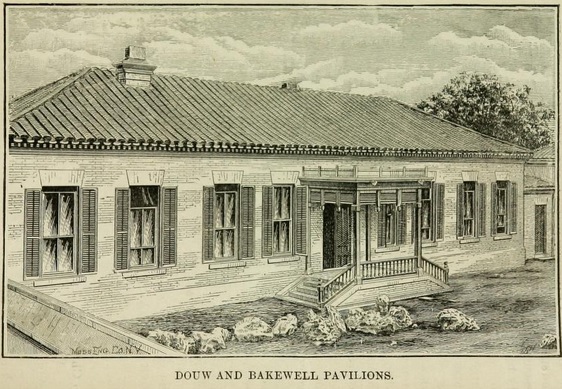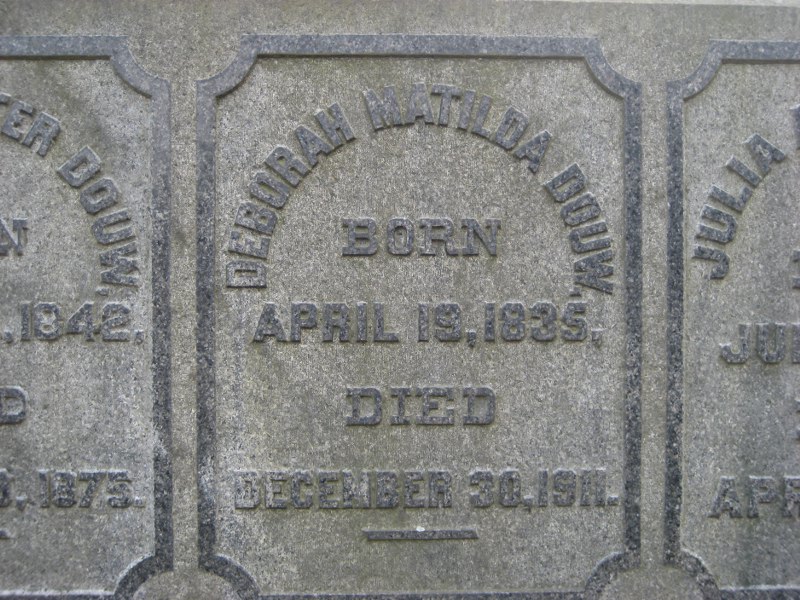北京潞河醫院
- 1878—1881年,美國基督教會公理會傳教士江戴德在通州城內北後街開設診療所。
- 1882年,美國醫師盈亨利以診所為基礎成立醫院,命名為婦嬰醫院。
- 1903年,美國傳教士都春甫重建醫院,並將醫院更名為潞河醫院。
- 1941年12月25日,醫院更名為通縣縣立醫院。
- 1945年1月11日,醫院更名為燕京道道立醫院。
- 1951年4月16日,醫院更名為潞河醫院人民醫院。
- 1958年,通縣改為通州區,醫院隨之更名為北京市通州區醫院。
- 1960年2月,通州區改為通縣,醫院隨之更名為通縣醫院。
1878美國基督教會公理會傳教士江戴德在通州城內北後街開設診療所。
1882年,美國醫師盈亨利在診療所的基礎上成立醫院,命名為“婦嬰醫院”。
2014年成為首都醫科大學附屬北京潞河醫院。
北京道濟醫院
 1886
1886
1863年美國傳教士道濟在北京曾經目睹了令其撕心裂肺的接生場麵:一孕婦難產,孩子的腳露出一隻,接生婆把一隻鞋穿在孩子的腳上,意思讓孩子自己走出來,最後的結局是大人和孩子雙亡。
這位美國女傳教士看到這種場景之後,回到家裏大哭了一場!
道濟返回美國,用8年的時間,募捐籌備8萬美元再回到北京。她於1885年在北京創辦了中國第一個婦嬰專科醫院。1917年更名為道濟醫院,1952年被北京市政府更名為北京市第六醫院。
正是這所最初的美國教會醫院,第一個把西方先進的新接生法帶進了古老的中國,將西醫先進的醫學理念播種在華廈大地,成為中西方文化觀念、醫學技術交流、融合最早的承載體之一。
道濟醫院(英語:Douw Hospital for Women and Children)是1885年成立的一家西醫醫院,也是北京市區最早的西醫醫院,以婦產科見長。該院在推廣新法接生、預防接種和培養中國醫務人員等方麵,做出了重大貢獻。該院於1952年被北京市政府接管,改稱「北京市第六醫院」。

安定醫院與福音堂

一百年前的道濟醫院(第六醫院前身)門診樓,此樓解放後為針灸科使用
美國長老教會傳教士道濟來華,看到當時中國的接生方法落後,許多嬰兒出生幾天就死去。她因此大哭一場,返回美國,以8年時間在各教會募集資金,婦產醫院於1880年秋季開始興建,1885年在臨時建築開始看病,1886年3月開始使用完工的永久性建築,建築費用$11,500美金,藥物與器材$2,000美金,每年營運成本$3,000美金。當時名為“婦嬰專科醫院”,院址在北京安定門交道口北二條,建了平房12間,醫院隻設婦產科和兒科,主要是推廣新法接生。該院1904年創辦護士訓練班,1908成立“道濟高級護士學校”,這是北京最早的護士學校,從1908年—1948年共畢業護士、助產士161人。[3][1][4]該院首任院長是女醫學博士Marion E. Sinclair,護理和培養護士的工作由Jennie McKillican小姐負責。[1][5]1895年秋,女醫學博士Eliza Ellen Leonard接任院長。[1][6][7]義和團運動期間醫院被迫關閉,1902年秋重新開門,就醫人數逐漸恢複。[8]以1907年為例,該院藥房處方6,704次,住院62人,出診124次。[9]
1917年醫院用庚子賠款在原址北麵建了一棟三層樓,與長老教會的男醫院“安定醫院”合並,為了紀念於1911年逝世的道濟,改稱“道濟醫院”,增設男科,以骨科和普通外科見長,能做一些大手術。共有病床30張,其中男床10張,女床10張,婦產科10張。1920年醫院原址西側的二層樓落成,病床增加到60張。

道濟(中間)
1900年,中國發生了震驚世界的“義和團事件",道濟與一些傳教士被義和團圍困在領事館,最終由一支聯合國部隊獲救送回美國。回到美國後,每當想起義和團燒毀教堂、醫院以及學校,將外國宣教士與中國教民梟首示眾,剖心棄屍,她就淚流不止。直到1911年,她在悲傷中去世。
“義和團事件"結束後,1917年,為了紀念道濟在中國的貢獻,醫院利用庚子賠款在原址再建一棟三層樓,與長老會建立的另一所男子醫院合並,醫院用她的名字命名“道濟醫院”。”新中國"建立後,1952年,道濟醫院被北京市政府更名為北京市第六醫院。 今天,中國的婦女生孩子再也不用擔心“過鬼門關”,也不用擔心孩子得“破傷風”夭折。預產期一到,在丈夫的陪同下開開心心走進婦產科醫院,等待著孩子降生。。。然而,有多少婦女知道美國這位女宣教士的名字呢?


Deborah Matilda Douw (1835-1911) funded and took part in missionary work in China. In 1900 she was caught up in the Boxer Rebellion.
Douw’s father was Volckert Pieter Douw, a land owner inAlbany, New York, whose family had arrived from Holland and settled in 1638. Douw’s mother was Helen Louise Franchot, daughter of Judge Stanislas Pascal Franchot, who was born in France and settled inOswego County, New York.[1] Douw was born on April 19, 1835, the eldest of eight children. Her family home was Wolvenhoeck, Greenbush on the east bank of the Hudson. By intermarriage she was related to many of the old and influential families including: Van Rensselaer, Beekman, Ten Broeck, De Peyster, Van Cortlandt and Livingston.
In 1869 Douw made her first visit to China on behalf of the Woman's Union Missionary Society of America for Heathen Lands (WUMS). [Note 1] She went to Beijing with two other women, Mrs Catherine Bonney and Miss Emily Adams, to open a boarding school for girls. In 1881 the mission was moved to Shanghai at which time a day-school was added to the facility. WUMS was one of the first organisations to permit single women to carry out this type of missionary work. They played an important role, working with women in situations where the presence of male missionaries would be inappropriate or forbidden. Some years later Douw funded the building of a female pavilion at the Pekin Presbyterian Hospital and paid for the attendance of a female doctor for this same reason. The hospital was run by Boudinot Currie Atterbury, a Presbyterian doctor from a wealthy family in America.[2] Douw, was related to Atterbury via the Van Rensselaer family and she became one of his largest sponsors.
Douw returned several times to China to continue her work. She set up a fund with the Woman’s Union Missionary Society of America for evangelistic work in Shanghai called the Douw Foundation.[3] This supported two missionaries, a bible school and women teachers. She also funded her own Christian Alliance Mission in Beijing.[4] In 1900 she was at the mission during the Boxer Rebellion when she and other missionaries were trapped in the foreign Legations. They were eventually rescued by a combined international force of troops and she returned to America, but never fully recovered from this experience and died in 1911.[5]
| 圖文提供 通訊員/侯小勇 舊址位於北京東城區安定門內大街322號的安定醫院,其前身是美國長老會於1885年所創建的女子醫院,距今已有131年的曆史,比大名鼎鼎的協和醫院早三十年。
l883年,美國基督教長老會海外傳道會派團來北京。女宣教士Douw. D. M隨團來到北京。她在傳福音中發現醫療條件極其落後,特別突出的是接生問題,不久之後她速返美國,向長老會募集資金及醫療宣教士。
1885年,Douw. D. M利用美國基督教長老會所捐之款,在安定門交道口北二條建平房l2間,這就是道濟醫院的前身——婦嬰醫院。積極推廣新法接生,由美國女醫生Marian Sine1ain負責醫療和管理工作,Jenet Mekillian姊妹負責護理和培養護士的工作。建院初期,人們懷疑她們的動機和方法,就醫的人寥寥無幾。
1894年Lenard. F. E接替Sine1ain院長。
1901年,長老會買下交道口房產建成了安定醫院、道濟肺病療養院、崇實中學(含宿舍)和教堂,集醫院、學校、教會於安內大頭條、二條、三條偌大的一個地區。
1904年,婦嬰醫院經過幾年的宣傳和實踐,西醫的長處漸漸被人們認識,就診人數有所增加。於是Lenard和Jenet Mekillian積極培養中國助手,就在婦嬰醫院院內創辦附屬於醫院的護士學校,這就是道濟護士學校之始。
1917年,婦嬰醫院利用“庚子賠款”在原址的北麵又建起了一棟三層樓,隨後將長老會1901年在安定門外創辦的“安定男子醫院”合並。共有病床30張,其中男床10張,女床10張,婦產科l0張,為紀念創始人而命名為道濟醫院(Duow Hospital American Presbyterian Mission)。
1920年,醫院原址西側的二層樓落成,病床增加到60張,醫院的設備漸漸完善,工作範圍亦有所擴大。
1921年Lenard在京病逝,Bashes.E. N繼任醫長,醫院步人了鼎盛時期,在京城內外影響很大。與協和醫院(王府井帥府園1號)、同仁醫院(崇文門內大街2號)、潞河醫院(通縣)及長老會在華北的保定思羅醫院、天津大眾醫院、邢台福音醫院和順德府(邯鄲)福音醫院等共同構成了華北的西洋醫學網。
1935年,道濟醫院成立董事會管理醫院,第一屆由7人組成,其中2名美國人,1名荷蘭人,4名中國人,董事長由當時的外交部長胡維德的夫人(梁啟超的女兒)擔任。董事會共有4屆,後3屆的董事長均由陸崇瑋擔任,所有權仍歸長老會。
1941年,太平洋戰爭爆發,日本侵略者將醫院查封,護校被迫停止招生。
1942年,醫院被日偽北京特別市衛生局強行接管,改名為北京市第三醫院。聘郭德隆為院長。同年Bashes因癌症在協和醫院病逝。協和醫院被查封後,各科專家先後來道濟醫院上班,有林巧稚、鄧家棟、張安、關頌韜、範琪等。協和護校也並入道濟護校。
1945年8月日本投降後,長老會牧師Mellis. B. R收回醫院,恢複道濟醫院名稱,但醫院設備已經損失大半。董事會聘張雲楷為院長,1946年張辭職。長老會又聘美國Henke. J. H為院長,私立衛黎癆醫院並入,增設結核科病床10張,此時總床位達70張。
1949年北京解放,醫院改為委員會製,Henke辭職,中國人張子榮任院長。
1950年美國津貼中斷,政府與長老會合辦醫院。
1952年,美國醫療宣教士被迫全部撤回,北京市衛生局接管,改稱北京市第六醫院,延續至今。張子榮繼任院長,他是道濟醫院最後一任院長,也是北京市第六醫院首任院長。接管時醫院教職員工192人,其中牧師1名,布道員3名,主治醫師以上5名,住院醫師14名,醫士5名,護士42名,助產士36名,醫技16名,行政及工人70名。分為內、外、婦、兒、口腔、放射、藥房和檢驗科。病床總數124張。全院擁有3座樓房和一棟平房,共199間,約6000平方米。
-----------
1941年太平洋戰爭爆發後,日本侵略者以美國敵產為由將醫院查封。不久,中國人以中華基督教會和董事會的名義收回醫院繼辦,更名“北京市第三醫院”,聘郭德隆為院長。同年Bashes因癌症在協和醫院病逝。協和醫院被查封後,各科專家先後來道濟醫院上班,有林巧稚、鄧家棟、張安、關頌韜、範琪等。協和護校也並入道濟護校②。
1945年8月日本投降,長老會牧師Mellis.B.R收回醫院,恢複道濟醫院名稱,但醫院設備已經損失大半。董事會聘張雲楷為院長,1946年張辭職。長老會又聘美國Henke.J.H為院長,私立衛黎癆醫院並入,增設結核科病床10張,此時總床位達70張。* @6 A: H3 j3 r5 t$ x. x 1949年北京解放,醫院改為委員會製,Henke辭職,中國人張子榮任院長。1950年美國津貼中斷,政府與長老會合辦醫院。1952年美國人全部撤回,北京市衛生局接管,改稱北京市第六醫院,張子榮繼任院長,他是道濟醫院最後一任院長,也是北京市第六醫院首任院長。 接管時醫院教職員工192人,其中牧師1名,布道員3名,主治醫師以上5名,住院醫師14名,醫士5名,護士42名,助產士36名,醫技16名,行政及工人70名。分為內、外、婦、兒、口腔、放射、藥房和檢驗科。病床總數124張。全院擁有3座樓房和一棟平房,共199間,約6000平方米。主要設備:50毫安X光機1台,便攜式X光機1台,顯微鏡6台,電冰箱2台以及一般手術室、病房、化驗設備。有汽車4輛(大卡車、小吉普、中吉普及道濟中載重)。 =============
|
Notes
中國第一家西醫醫院是廣州博濟醫院,更廣為人知的廣州真光眼科醫院。它由彼得·伯駕(Peter Parker,1804-1888)於1835年11月4日在廣州一家外商獨資工廠附近的十三行(綠豌豆街)7號成立。在清朝(1644-1911),廣州是唯一可以在歐洲和中國商人之間進行貿易的地方。這唯一的貿易港在第一次鴉片戰爭(1839-1842)之後也就不複存在了,因為清政府阻止外國人,主要是英國人,走私鴉片的行動。因為戰爭失敗,清政府不僅讓英國人恢複了在中國境內的販毒活動,也為向外商開放遼闊的中國市場,並讓傳教士進入中國鋪平了道路。
在過去的一百七十六年裏,中國第一家西式醫院廣州眼科醫院幸存下來,並且蓬勃發展。它已成為全國最大,最負盛名的眼科研究機構之一。目前,該中心有724名工作人員,其中包括170名眼科醫生。
德博拉·瑪蒂爾·杜(Deborah Matilda Douw 1835-1911)資助並參加了在中國的傳教工作。 1900年,她被義和團抓獲。 1869年,杜女士代表美國婦女聯合會宣教協會海外宣教部(WUMS)首次訪問中國。她與另外兩名女性一起去北京為女孩開設寄宿學校。 1881年,該任務被移至上海,當時在該設施中增加了一所日間的女子學校。 WUMS是首批允許單身女性進行這種傳教工作的組織之一。這些學校發揮了重要作用,特別是在不適合男性傳教士工作的情況,甚至在禁止男性傳教士工作的領域,可以由女性傳教士來為女性服務。
Douw多次回到中國繼續工作,並與美國婦女聯合會傳教協會一起在上海為福音工作組織了一個名為Douw基金會的基金。這基金會支持了兩個傳教士,一所聖經學校和女教師們。她還資助她在北京的基督教聯盟機構。此外,Douw資助在北京長老會醫院建造一個女性病房,並為在那裏的一位女醫生支付費用。 1900年,當義和團運動的時候,她與其他傳教士被困在外國使館內。雖然他們最終由聯合的國際部隊獲救,她返回美國,但她從未完全從這次經曆中恢複過來,並於1911年去世。
隨著時間的推移,19世紀中國醫院的擴大和發展越來越被廣泛接受。到1937年,中國有254所教會醫院,但其中一半以上最終因第二次世界大戰期間的日本爆炸事件或第二次甲午戰爭或中國內戰而遭到破壞。第二次世界大戰後,這些醫院中的大部分至少部分得到了康複,最終轉移到中華人民共和國政府的管轄之下,但仍然作為醫院。
The first Western-style hospital in China was the Canton Hospital, better known as the Ophthalmic Hospital in Canton. It was founded by Peter Parker (1804–1888), at Factory No. 7, Fung-taihong San-taulan (Green Pea) Street, a site near the foreign-owned factories in Canton (now known as Guangzhou), on November 4, 1835. During the Qing Dynasty (1644–1911), Canton was the only place trade could be undertaken between European and Chinese merchants. The trade monopoly ended after the first Opium War (1839–1842), which had begun in response to the attempt of the Qing government to halt the illegal smuggling of opium by foreign, mainly English, ships in Canton. The failures of the Qing government during the war not only allowed the English to resume drug trafficking within China but also paved the way for the opening of lucrative Chinese markets to business people and of Chinese society to missionaries.
During the past 176 years, the first Western-style hospital in China, the Ophthalmic Hospital in Canton, has survived and thrived; it has become the leading ophthalmic institute in the country and one of the largest and most prestigious in the world. Currently, 724 staff members, including 170 ophthalmologists, work in the center.
Deborah Matilda Douw (1835-1911) funded and took part in missionary work in China. In 1900 she was caught up in the Boxer Rebellion. In 1869, Douw made her first visit to China on behalf of the Women's Union Missionary Society of America for Heathen Lands (WUMS). She went to Beijing with two other women to open a boarding school for girls. In 1881 the mission was moved to Shanghai at which time a day-school was added to the facility. WUMS was one of the first organizations to permit single women to carry out this type of missionary work. These schools played an important role, working with women in situations where the presence of male missionaries would be inappropriate or forbidden.
Douw returned several times to China to continue her work, and she set up a fund with the Woman’s Union Missionary Society of America for evangelistic work in Shanghai called the Douw Foundation. This supported two missionaries, a bible school and women teachers. She also funded her own Christian Alliance Mission in Beijing. In addition, Douw funded the building of a female pavilion at the Peking Presbyterian Hospital and paid for the attendance of a female doctor. In 1900 she was at the mission during the Boxer Rebellion when she and other missionaries were trapped in the foreign legations. Though they were eventually rescued by a combined international force of troops and she returned to America, she never fully recovered from this experience and died in 1911.
With time the expansion and growth of hospitals in China during the 1800s became more widely accepted. By 1937 there were 254 mission hospitals in China, but more than half of these were eventually destroyed by Japanese bombing during World War II or otherwise due to the Second Sino-Japanese War or the Chinese Civil War. After World War II most of these hospitals were at least partially rehabilitated, and eventually passed to the control of the Government of the Peoples' Republic of China, but are still functioning as hospitals.
http://cnwmw.blogspot.com/2017/12/blog-post_53.html




 選擇“Disable on www.wenxuecity.com”
選擇“Disable on www.wenxuecity.com”
 選擇“don't run on pages on this domain”
選擇“don't run on pages on this domain”

